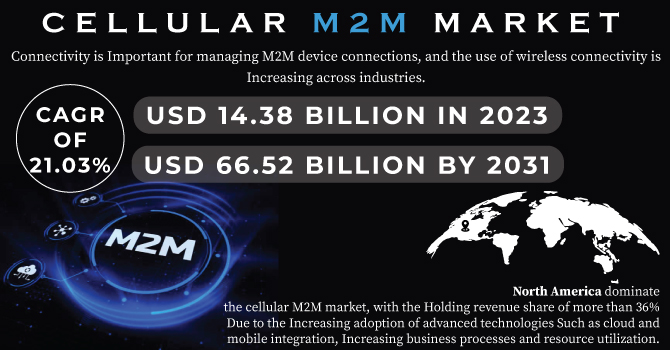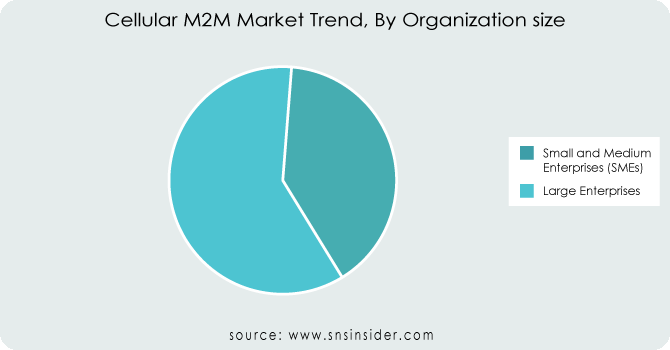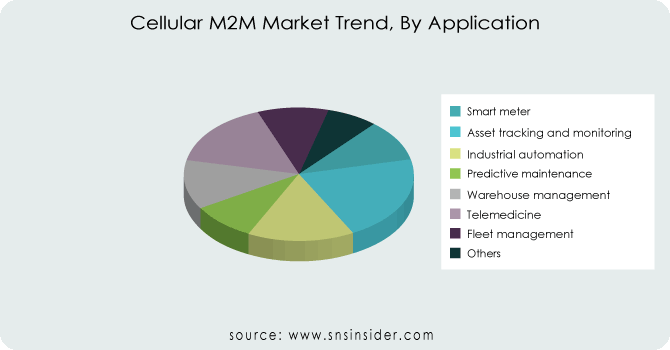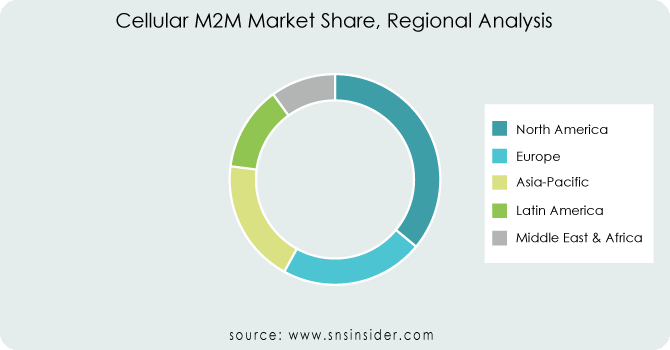The Cellular M2M Market Size was valued at USD 14.38 Billion in 2023 and is expected to reach USD 66.52 Billion by 2031 and grow at a CAGR of 21.03 % over the forecast period 2024-2031.
Connectivity is Important for managing M2M device connections, and the use of wireless connectivity is Increasing across industries. M2M facilitates widespread connectivity for enterprises with devices in various locations. Cellular M2M professional services cater to the technological requirements of organizations involved in creating new M2M applications. These services focus on executing effective M2M programs using a blend of people, processes, and data technologies. Wireless networking, particularly through cellular networks, enables M2M communications over wide areas. The growth of high-speed internet and technologies like 4G and 5G is expected to drive the cellular M2M market, expanding its customer base with improved telecommunication infrastructure.

Get More Information on Cellular M2M Market - Request Sample Report
Drivers:
Increasing adoption of wireless connectivity across industries is driving the demand for cellular M2M solutions.
The Cellular M2M enables connectivity for enterprises with devices in geographically dispersed locations, expanding its market potential.
The Cellular M2M services focus on executing superior M2M programs tailored to meet client needs using a mix of people, processes, and data technologies.
Growth in high-speed internet and technologies like 4G and 5G is driving the cellular M2M market by enhancing connectivity capabilities.
Increasing the integration of software applications in devices to improve performance.
The Increasing adoption of wireless connectivity in various industries is creating the demand for cellular Machine-to-Machine (M2M) solutions. This is due to the growing need for Uninterrupted communication between devices, sensors, and systems, in Various geographically spread locations. Cellular M2M technology Provide a strong and scalable platform for transmitting data and enabling real-time monitoring and control, helps to increase efficiency, productivity, and operational insights for businesses. The advancements in cellular networks, such as 4G and 5G, are helping to drive the adoption of cellular M2M solutions by providing faster speeds, lower latency, and enhanced connectivity capabilities.
Restraints:
The Implementation of cellular M2M solutions can require high initial investment in technology and infrastructure.
The increased use of wireless connectivity raises concerns about data security and privacy challenges for cellular M2M deployments.
Compliance with regulatory requirements related to data transmission and communication protocols can be complex, especially in highly regulated industries.
Reliability and coverage issues in cellular networks can impact the effectiveness of M2M communications, and operational challenges.
Ensuring interoperability and compatibility between different M2M devices and networks can be a challenge.
The Implementing cellular M2M solutions often involves significant Initial costs for acquiring the necessary technology and infrastructure. These investments are required to establish a reliable and secure communication network for M2M devices and systems. the increased Dependance on wireless connectivity in M2M deployments raises concerns about data security and privacy risks. Organizations need to address these challenges by implementing robust security measures and compliance protocols to safeguard sensitive data and ensure regulatory compliance in cellular M2M environments.
Opportunities:
The continuous growing telecommunication infrastructure and high-speed internet create opportunities for the cellular M2M market.
The Ongoing advancements in 4G and 5G technologies create opportunities for enhanced connectivity and improved M2M capabilities.
The Cellular M2M solutions can integrate with IoT platforms, creating opportunities for innovative applications and services across industries.
Customized cellular M2M solutions tailored to specific industry needs, such as healthcare, automotive, and logistics, offer growth opportunities.
The technology use, such as big data and analytics, is rising.
The Cellular M2M enables global connectivity, allowing businesses to expand their operations internationally and reach new markets.
Challenges:
Ensuring consistent and reliable network coverage, especially in remote or challenging environments, remains a challenge for cellular M2M deployments.
Scalability issues is growing due to the number of connected devices increases, requiring robust infrastructure and management capabilities.
The Handling large volumes of M2M data, including storage, processing, and analysis, presents challenges for organizations in terms of data management.
Integrating cellular M2M solutions with existing IT systems and applications can be complex, requiring seamless integration to avoid disruptions.
The cellular M2M market is highly competitive, with multiple vendors offering solutions, making it challenging.
The Russia-Ukraine crisis is anticipated to create a impact on the Cellular M2M Market Sanctions against Russia could restrict access to crucial technologies and expertise essential for M2M advancement, potentially slowing down innovation and deployment in certain regions. In producing key materials for cellular technology, disruptions in the Russia-Ukraine supply chain may lead to shortages and price increases for M2M components. The crisis may drive a heightened need for remote monitoring solutions, particularly in critical infrastructure and security applications, benefiting specific segments of the Cellular M2M market. the Cellular M2M market is still poised for considerable growth due to persistent trends such as automation and increasing adoption of the Internet of Things (IoT).
The economic downturn Results to decrease in investment in new technologies and infrastructure upgrades for the Cellular Machine-to-Machine (M2M) market, the Businesses may prioritize cost-cutting measures over sustainability initiatives, leading to a potential 20% reduction in demand for M2M services. The downturn has also driven a 15% increase in interest in M2M solutions focused on optimizing processes and reducing operational costs. Despite challenges, M2M technologies are expected to play a important role in enhancing operational efficiency amid economic uncertainties.
By Services
Connectivity services
Professional services
Managed services
By organization size
Large Enterprises
Small and Medium Enterprises (SMEs)
On the basis of Organization size, The large enterprises segment dominate the market with the Holding Revenue share of More than 65% of cellular M2M market. Cellular M2M service providers assist these enterprises in optimizing their network infrastructure, deploying advanced applications to reduce operational costs and improve efficiency, addressing IoT device issues, and identifying and mitigating security threats. Their focus is on adopting industry-specific solutions to enhance operational efficiency.

By application
Asset tracking and monitoring
Predictive maintenance
Telemedicine
Fleet management.
Industrial automation
Smart meter
Others
On the basis of Application, The Asset tracking and monitoring segment dominate the market with the Holding Revenue share of More than 22%. This application addresses issues such as asset theft, loss, and operational inefficiencies by enabling businesses to track their assets effectively. It Increase the employee safety, automates processes, and optimizes the supply chain. It also plays a important role in maintaining asset health and serves as a valuable troubleshooting tool during emergencies.

Get Customized Report as per Your Business Requirement - Request For Customized Report
By End User
Healthcare
Energy and utilities
Transportation and logistics
Manufacturing
Others
North America dominate the cellular M2M market, with the Holding revenue share of more than 36% Due to the Increasing adoption of advanced technologies Such as cloud and mobile integration, Increasing business processes and resource utilization. The region’s increase in deploying M2M mobile applications for secure document transfer and collaboration among geographically dispersed teams. Major players like AT&T, Verizon, and T-Mobile, headquartered in North America, provide robust M2M solutions globally. In Europe, strong healthcare infrastructure contributes to the region's significant market share, with Germany and the UK showing notable growth. The Asia-Pacific market Is Expected growing with the Highest Compound annual growth Rate During forecast period, driven by IoT adoption, with China leading in market share and India experiencing rapid growth.

REGIONAL COVERAGE:
North America
US
Canada
Mexico
Europe
Eastern Europe
Poland
Romania
Hungary
Turkey
Rest of Eastern Europe
Western Europe
Germany
France
UK
Italy
Spain
Netherlands
Switzerland
Austria
Rest of Western Europe
Asia Pacific
China
India
Japan
South Korea
Vietnam
Singapore
Australia
Rest of Asia Pacific
Middle East & Africa
Middle East
UAE
Egypt
Saudi Arabia
Qatar
Rest of the Middle East
Africa
Nigeria
South Africa
Rest of Africa
Latin America
Brazil
Argentina
Colombia
Rest of Latin America
The major key players are AT&T, Verizon Communications Inc., T-Mobile, Vodafone, Orange S.A., Telefónica, S.A., Deutsche Telekom AG, Telefonaktiebolaget LM Ericsson, KORE Wireless Group, Aeris Communications India Pvt. Ltd., and other players mentioned in the final report..

| Report Attributes | Details |
| Market Size in 2023 | US$ 14.38 Bn |
| Market Size by 2031 | US$ 66.52 Bn |
| CAGR | CAGR of 18.9% From 2024 to 2031 |
| Base Year | 2023 |
| Forecast Period | 2024-2031 |
| Historical Data | 2020-2022 |
| Report Scope & Coverage | Market Size, Segments Analysis, Competitive Landscape, Regional Analysis, DROC & SWOT Analysis, Forecast Outlook |
| Key Segments | • By Services (Connectivity Services, Professional Services, and Managed Services) • By Application (Asset Tracking & Monitoring, Predictive Maintenance, Telemedicine, Fleet Management, Warehouse Management, Industrial Automation, Smart Meter, Others) • By Organization size (Large Enterprises and SMEs) • By End-User (Healthcare, Energy & Utilities, Transportation & Logistics, Manufacturing, Others) |
| Regional Analysis/Coverage | North America (USA, Canada, Mexico), Europe (Germany, UK, France, Italy, Spain, Netherlands, Rest of Europe), Asia-Pacific (Japan, South Korea, China, India, Australia, Rest of Asia-Pacific), The Middle East & Africa (Israel, UAE, South Africa, Rest of Middle East & Africa), Latin America (Brazil, Argentina, Rest of Latin America) |
| Company Profiles | AT&T, Verizon Communications Inc., T-Mobile, Vodafone, Orange S.A., Telefónica, S.A., Deutsche Telekom AG, Telefonaktiebolaget LM Ericsson, KORE Wireless Group, Aeris Communications India Pvt. Ltd. |
| Key Drivers | • Increasing adoption of wireless connectivity across industries is driving the demand for cellular M2M solutions. • The Cellular M2M enables connectivity for enterprises with devices in geographically dispersed locations, expanding its market potential. • The Cellular M2M services focus on executing superior M2M programs tailored to meet client needs using a mix of people, processes, and data technologies. |
| Market Opportunities | • The continuous growing telecommunication infrastructure and high-speed internet create opportunities for the cellular M2M market. • The Ongoing advancements in 4G and 5G technologies create opportunities for enhanced connectivity and improved M2M capabilities. • The Cellular M2M solutions can integrate with IoT platforms, creating opportunities for innovative applications and services across industries. |
Ans. The Compound Annual Growth rate for the Cellular M2M Market over the forecast period is 21.03%.
Ans. The projected market size for the Cellular M2M Market is USD 66.52 billion by 2031.
Ans: The Asset Tracking & Monitoring Application segment dominated the Cellular M2M Market.
Ans: North America region is dominant in Cellular M2M Market.
Ans:
TABLE OF CONTENTS
1. Introduction
1.1 Market Definition
1.2 Scope
1.3 Research Assumptions
2. Industry Flowchart
3. Research Methodology
4. Market Dynamics
4.1 Drivers
4.2 Restraints
4.3 Opportunities
4.4 Challenges
5. Impact Analysis
5.1 Impact of Russia-Ukraine Crisis
5.2 Impact of Economic Slowdown on Major Countries
5.2.1 Introduction
5.2.2 United States
5.2.3 Canada
5.2.4 Germany
5.2.5 France
5.2.6 UK
5.2.7 China
5.2.8 Japan
5.2.9 South Korea
5.2.9 India
6. Value Chain Analysis
7. Porter’s 5 Forces Model
8. Pest Analysis
9. Cellular M2M Market, By services
9.1 Introduction
9.2 Trend Analysis
9.3 Connectivity services
9.4 Professional services
9.5 Managed services
10. Cellular M2M Market, By organization size
10.1 Introduction
10.2 Trend Analysis
10.3 Large Enterprises
10.4 Small and Medium Enterprises (SMEs)
11. Cellular M2M Market, By application
11.1 Introduction
11.2 Trend Analysis
11.3 Asset tracking and monitoring
11.4 Predictive maintenance
11.5 Telemedicine
11.6 Fleet management.
11.7 Warehouse management
11.8 Industrial automation
11.9 Smart meter
11.10 Others
12. Cellular M2M Market, By end user
12.1 Introduction
12.2 Trend Analysis
12.3 Manufacturing
12.3.1 Food & Beverages
12.3.2 Metals & Mining
12.3.3 Healthcare
13.4 Energy and utilities
13.5 Transportation and logistics
13.6 Manufacturing
13.7 Others
13. Regional Analysis
13.1 Introduction
14.2 North America
14.2.1 USA
14.2.2 Canada
14.2.3 Mexico
14.3 Europe
14.3.1 Eastern Europe
14.3.1.1 Poland
14.3.1.2 Romania
14.3.1.3 Hungary
14.3.1.4 Turkey
14.3.1.5 Rest of Eastern Europe
14.3.2 Western Europe
14.3.2.1 Germany
14.3.2.2 France
14.3.2.3 UK
14.3.2.4 Italy
14.3.2.5 Spain
14.3.2.6 Netherlands
14.3.2.7 Switzerland
14.3.2.8 Austria
14.3.2.9 Rest of Western Europe
14.4 Asia-Pacific
14.4.1 China
14.4.2 India
14.4.3 Japan
14.4.4 South Korea
14.4.5 Vietnam
14.4.6 Singapore
14.4.7 Australia
14.4.8 Rest of Asia Pacific
14.5 The Middle East & Africa
14.5.1 Middle East
14.5.1.1 UAE
14.5.1.2 Egypt
14.5.1.3 Saudi Arabia
14.5.1.4 Qatar
14.5.1.5 Rest of the Middle East
14.5.2 Africa
14.5.2.1 Nigeria
14.5.2.2 South Africa
14.5.2.3 Rest of Africa
14.6 Latin America
14.6.1 Brazil
14.6.2 Argentina
14.6.3 Colombia
14.6.4 Rest of Latin America
15. Company Profiles
15.1 AT&T
15.1.1 Company Overview
15.1.2 Financials
15.1.3 Products/ Services Offered
15.1.4 SWOT Analysis
15.1.5 The SNS View
15.2 Verizon Communications Inc.
15.2.1 Company Overview
15.2.2 Financials
15.2.3 Products/ Services Offered
15.2.4 SWOT Analysis
15.2.5 The SNS View
15.3 T-Mobile
15.3.1 Company Overview
15.3.2 Financials
15.3.3 Products/ Services Offered
15.3.4 SWOT Analysis
15.3.5 The SNS View
15.4 Orange S.A.
15.4 Company Overview
15.4.2 Financials
15.4.3 Products/ Services Offered
15.4.4 SWOT Analysis
15.4.5 The SNS View
15.5 Vodafone
15.5.1 Company Overview
15.5.2 Financials
15.5.3 Products/ Services Offered
15.5.4 SWOT Analysis
15.5.5 The SNS View
15.6 Telefónica, S.A.
15.6.1 Company Overview
15.6.2 Financials
15.6.3 Products/ Services Offered
15.6.4 SWOT Analysis
15.6.5 The SNS View
15.7 Deutsche Telekom AG
15.7.1 Company Overview
15.7.2 Financials
15.7.3 Products/ Services Offered
15.7.4 SWOT Analysis
15.7.5 The SNS View
15.8 Telefonaktiebolaget LM Ericsson
15.8.1 Company Overview
15.8.2 Financials
15.8.3 Products/ Services Offered
15.8.4 SWOT Analysis
15.8.5 The SNS View
15.9 Aeris Communications India Pvt. Ltd.
15.9.1 Company Overview
15.9.2 Financials
15.9.3 Products/ Services Offered
15.9.4 SWOT Analysis
15.9.5 The SNS View
15.10 KORE Wireless Group
15.10.1 Company Overview
15.10.2 Financials
15.10.3 Products/ Services Offered
15.10.4 SWOT Analysis
15.10.5 The SNS View
16. Competitive Landscape
16.1 Competitive Benchmarking
16.2 Market Share Analysis
16.3 Recent Developments
16.3.1 Industry News
16.3.2 Company News
16.3.3 Mergers & Acquisitions
17. USE Cases and Best Practices
18. Conclusion
An accurate research report requires proper strategizing as well as implementation. There are multiple factors involved in the completion of good and accurate research report and selecting the best methodology to compete the research is the toughest part. Since the research reports we provide play a crucial role in any company’s decision-making process, therefore we at SNS Insider always believe that we should choose the best method which gives us results closer to reality. This allows us to reach at a stage wherein we can provide our clients best and accurate investment to output ratio.
Each report that we prepare takes a timeframe of 350-400 business hours for production. Starting from the selection of titles through a couple of in-depth brain storming session to the final QC process before uploading our titles on our website we dedicate around 350 working hours. The titles are selected based on their current market cap and the foreseen CAGR and growth.
The 5 steps process:
Step 1: Secondary Research:
Secondary Research or Desk Research is as the name suggests is a research process wherein, we collect data through the readily available information. In this process we use various paid and unpaid databases which our team has access to and gather data through the same. This includes examining of listed companies’ annual reports, Journals, SEC filling etc. Apart from this our team has access to various associations across the globe across different industries. Lastly, we have exchange relationships with various university as well as individual libraries.

Step 2: Primary Research
When we talk about primary research, it is a type of study in which the researchers collect relevant data samples directly, rather than relying on previously collected data. This type of research is focused on gaining content specific facts that can be sued to solve specific problems. Since the collected data is fresh and first hand therefore it makes the study more accurate and genuine.
We at SNS Insider have divided Primary Research into 2 parts.
Part 1 wherein we interview the KOLs of major players as well as the upcoming ones across various geographic regions. This allows us to have their view over the market scenario and acts as an important tool to come closer to the accurate market numbers. As many as 45 paid and unpaid primary interviews are taken from both the demand and supply side of the industry to make sure we land at an accurate judgement and analysis of the market.
This step involves the triangulation of data wherein our team analyses the interview transcripts, online survey responses and observation of on filed participants. The below mentioned chart should give a better understanding of the part 1 of the primary interview.

Part 2: In this part of primary research the data collected via secondary research and the part 1 of the primary research is validated with the interviews from individual consultants and subject matter experts.
Consultants are those set of people who have at least 12 years of experience and expertise within the industry whereas Subject Matter Experts are those with at least 15 years of experience behind their back within the same space. The data with the help of two main processes i.e., FGDs (Focused Group Discussions) and IDs (Individual Discussions). This gives us a 3rd party nonbiased primary view of the market scenario making it a more dependable one while collation of the data pointers.
Step 3: Data Bank Validation
Once all the information is collected via primary and secondary sources, we run that information for data validation. At our intelligence centre our research heads track a lot of information related to the market which includes the quarterly reports, the daily stock prices, and other relevant information. Our data bank server gets updated every fortnight and that is how the information which we collected using our primary and secondary information is revalidated in real time.

Step 4: QA/QC Process
After all the data collection and validation our team does a final level of quality check and quality assurance to get rid of any unwanted or undesired mistakes. This might include but not limited to getting rid of the any typos, duplication of numbers or missing of any important information. The people involved in this process include technical content writers, research heads and graphics people. Once this process is completed the title gets uploader on our platform for our clients to read it.
Step 5: Final QC/QA Process:
This is the last process and comes when the client has ordered the study. In this process a final QA/QC is done before the study is emailed to the client. Since we believe in giving our clients a good experience of our research studies, therefore, to make sure that we do not lack at our end in any way humanly possible we do a final round of quality check and then dispatch the study to the client.
The Knowledge Process Outsourcing [KPO] Market was worth USD 39.32 billion in 2022 and is predicted to be worth USD 123.66 billion by 2030, growing at a 15.4% CAGR between 2023 and 2030.
The Customer Intelligence Platform Market size was USD 1.9 billion in 2022 and is expected to Reach USD 15.4 billion by 2030 and grow at a CAGR of 30 % over the forecast period of 2023-2030.
The 5G Security Market size was valued at USD 1.87 billion in 2022 and is expected to grow to USD 27.28 billion By 2030 and grow at a CAGR of 39.8 % over the forecast period of 2023-2030.
The Cinema Camera Market size was valued at USD 291.5 million in 2022 and is expected to grow to USD 461.1 million by 2030 and grow at a CAGR of 5.9 % over the forecast period of 2023-2030.
The Concierge Services Market size was valued at USD 856.4 Billion in 2023 and is expected to reach USD 1449.6 Billion by 2031 and grow at a CAGR of 6.8% over the forecast period 2024-2031.
The Network Forensics Market size was valued at US$ 1.33 Billion in 2023 and is expected to reach US$ 3.17 Billion by 2031 and grow at a CAGR of 11.4% over the forecast period 2024-2031.
Hi! Click one of our member below to chat on Phone